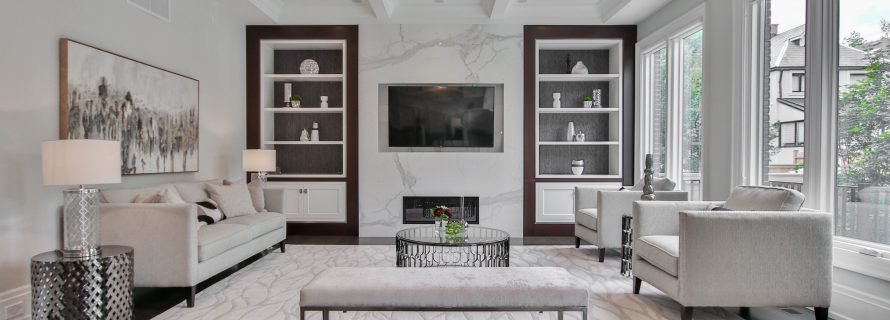Creating a Minimalist Living Space

You may have seen posts about living minimally or noticed the recent flood of interior decorating photos on the internet boasting in simplicity. Maybe you’re intrigued by the lifestyle, or maybe you don’t understand the benefits and why someone would choose to live with less. Either way, learning about the pros and cons of living minimally will give you a better idea of whether or not it’s right for you — and how to change your living space if this lifestyle is for you.
One of the greatest benefits of living with less is the reduced overwhelm and increased energy. The fewer things you have to worry about taking care of and cleaning, the more time and energy you can spend on other things that matter more. You may also find that living a minimalist lifestyle uproots the comparison game because you’re less focused on keeping up with what everyone else owns and more interested in creating experiences and living a full life.
These benefits sound pretty good, don’t they? After all, who doesn’t want increased peace in their life? If you answered yes to either of those questions, it’s time to decide what kind of ground rules you’ll set for yourself on the road to creating a minimalist living space. Some people choose to only live with a set number of items, while others simply want to declutter. On the more extreme end, some people even choose to downsize their home to take up less space in the world. The beauty is that you get to decide what rules you will set — and these can evolve over time.
Here are a few tips to get you started:
- Use a limited amount of furniture: Lots of furniture can make a space feel cluttered and busy. To avoid this, use smaller furniture and use as few items as you can to make your space feel clean and simple.
- Declutter, declutter, declutter: You may have already guessed this step would be here. To live with less, you’ll need to get rid of many non-essential items and stick to the basics. Going through a lifetime of items can be difficult, but there are different methods to decluttering that can simplify the process. One such method is coined by Marie Kondo as the KonMari method. Rather than going through each room of your home and getting rid of things, you go through different categories at once so you can see your duplicates and nonessentials.
- Organize remaining items by category: Everything you decide to keep should be placed strategically. Continuing with the KonMari method, once you’ve determined what items are out and which ones are staying — keep the items in their designated category. Store tops with tops and pens with pens, rather than having several pens in different rooms and a few tops hanging up and a few in your dresser drawers.
- Clear all your surfaces: Another simple thing to do that can make your space feel more minimal in no time is to clear off your surfaces. This can mean countertops, fireplace mantles, side tables, etc. While you don’t have to clear everything off, it’s best to clear off as much as possible to help the room feel simple and give your eye less to focus on.
- Simplify your decorations: Getting carried away with decorations is easy to do. How are you to choose which of your daughter’s drawings to keep on the wall and which to take down? Keep all your decorations simple, particularly on the walls. Hanging a few pictures or drawings is okay, but having a crowded wall won’t help your space feel minimal. You might also consider keeping a soothing plant or two out to liven up the space, but getting rid of or moving any knick-knacks or other decorations that make the space feel cluttered.
- Use a set color palette and avoid patterns: To keep your space coordinated and simple, stick to a designated color scheme. When choosing your colors, keep in mind that minimalist living spaces should feel calming, so it’s best to avoid reds, oranges, or other harsh colors. Instead, consider going with blues, greens, or pinks, and including one or two neutral colors to tie everything together. When swapping out furniture or wall colors, you’ll also want to avoid patterns to avoid making the space feel busy.
Converting a space to feel more minimal is a great way to simplify your home and life. While the steps above will help you achieve this, you may also want to consider how you think minimalist living spaces should feel, and apply that to your own space. If you’re looking for more ways to level up your living space, check out these modern nautical design ideas for your home!
About The Author: Abby is a Content Marketing Specialist developing high-quality content for a variety of industries including lifestyle and finance. Her work can be seen featured on sites like Annuity.org and Turbotenant.
Photo by Sidekix Media on Unsplash
- Additions and New Construction
- All Exteriors
- Alterations
- Basements
- Bathrooms
- Customer Service
- Customer Stories
- Decks
- Design & Planning Show
- DIY
- Doors
- Educational Resources
- Extreme Makeover Home Edition
- Fashion Show
- General Remodeling
- Green Living
- Handyman Home Services
- Home Decor
- Home Entertainment
- Home Improvement
- Home Improvements
- How to Tips
- In The Community
- Kitchens
- Off-the-Wall Remodeling Stories
- Remodeling
- Resources
- Roofing
- Siding
- Social Media
- Sunrooms
- Tips & Tricks
- Trends
- Windows

